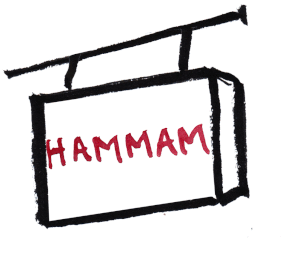Curiosity index No.3 AT THE BATHHOUSE
Dear Friends,
It’s winter in confined Paris and I’m spending time with my mother. She tells me in Istanbul she went to the Hammam (Turkish Bath) every morning before work. We associate Hammams with a place of leisure and lust. For her, since they didn’t have hot water, they were no different than public baths. Ingre’s well known painting Turkish Bath is more of a Harem scene, a fantasy based on the letters of Lady Montague. Although the 1997 film Hammam by Ferzan Ozpetek might prove me wrong on the sensuality part.
When I was little, my grandmother was the one who washed me and my waist long hair. The sun-filled bathroom had tiled floors, a kurna, two small wooden chairs and a metal bowl called tas. Water was heated in the kitchen and mixed with cold water in this kurna (a round marble sink placed on the floor). I am sitting on one wooden chair and she is sitting on the other right behind me. She always starts by pouring water on my hair with the silver tas. Then soap and untangle my hair with a coarse comb, more water for rinsing. We always finished with the body scrubbed gently with the kese, more water all over and the sign of the cross on the last tas filled with water. I am done, I wrap myself in the large towel with tassels and it’s now her turn.
My mother went to the hammam to bathe before work, but as a little girl she remembers it as a social place, where friends and family would spend afternoons getting cleaned, discussing, eating pomegranates by splitting them on the corner of the marble steps.
It's worth watching the poetic movie The Color of Pomegranates by Sergei Parajanov. The Armenian-Georgian filmmaker from Tibilisi (a city known for its Sulphur Baths) has beautiful scenes of the traditional bathing ritual and its objects.
As early as the 13th century all European cities had public baths; Paris had 27 in 1292. Around the 15th century, people started believing that water was responsible for spreading epidemics, and doctors thought that disease penetrated much easily in the body through open pores.
Continuing on the subject with my mother, for a moment we talked about the scrapers, the actual tool and the person (the lady who cleaned my mother had also scraped her grandmother—it was a profession like any other).
Bathing was part of life’s pleasures in the middle ages. In 12-13th century Iran, instead of kese(exfoliating glove made from a coarse fabric) scrapers were made of clay.
If you went to the Hammam, you had a bokdja (an embroidered square piece of fabric) in your hands, that wrapped the following items:
This is the music I imagine people listening in multiethnic Istanbul of the 1930's of my mother's childhood, by the Jewish-Greek singer of rebetiko Roza Eskenazi who also performed in the US in the 1950's.
After telling you all this, I have to confess: as a native of Istanbul... I have never been to a Hammam.
Thank you again for taking the time, please don’t hesitate to comment, share and open up your world to us.
HAPPY 2021!!!!
Lots of love, Talin
PS. In Augustus' time, Romans took pleasure in hanging baths. Sergius Orata's creation, a metal bathtub fitted with four heavy rings would hang from the ceiling of the bathhouse. Once the bather was in, servants would swing him at the desired rhythm during his entire bath.







